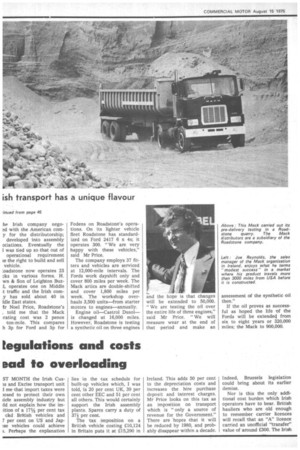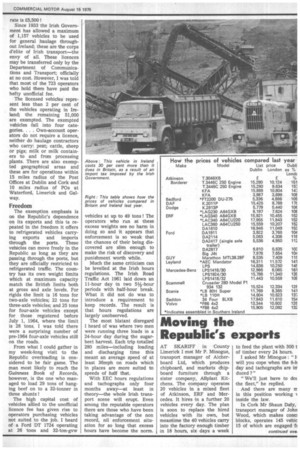tegulations and costs mad to overloading
Page 48

Page 49

If you've noticed an error in this article please click here to report it so we can fix it.
ST MONTH the Irish Cuss and Excise transport unit i me that import taxes were x)sed to prcetedt their own Lidle assembly industry but Id not explain how the imition of a 171/2 per cent tax ckd British vehicles and 7 per cent on US and Japse vehicles could achieve ;. Perhaps •the explanation lies in the tax schedule for built-up vehicles which, I was told, is 20 per cent UK, 39 per cent other EEC and 51 per cent all others. This would certainly support the Irish assembly plants. Spares carry a duty of 37i per cent.
The 'tax imposition on a British vehicle costing £10,124 in Britain puts it at £15,290 in Ireland. This adds 50 per cent to the depreciation costs and increases the hire purchase deposit and 'interest charges. Mr Price looks on this tax as an imposition on transport which is "only a source of revenue for the Government." There are "hopes that it will be reduced by 1980, and probably disappear within a decade. Indeed, Brussels legislation could bring about its earlier demise.
Nor •is this the only additional cost burden which Irish operators have to bear. British hauliers who •are old enough to remember carrier licences will recall that an "A" licence carried an unofficial "transfer" value of around £300. The Irish rate is £5,500 Since 1933 the Irish Government has allowed a maximum of 1,157 vehicles to be used for general haulage throughout Ireland; these are the corps d'elite of Irish transport-the envy of all. These licences may be transferred only by the Department of Communications and Transport; officially at no cost. However, I was told that most of the 723 operators who hold them have paid the hefty unofficial fee.
The licensed vehicles represent less than 2 per cent of the vehicles operating in Ireland; the remaining 51,000 are exempted. The exempted vehicles fall into four categories. . Own-account operators do not require a licence, neither do haulage contractors who carry: peat; cattle, sheep or pigs; milk or milk containers to and from processing plants. There are also exempted geographical areas and these are for operations within 15 miles radius of the Post Offices at Dublin and Cork and 10 miles radius of POs at Waterford, Limerick and Galway.
Freedom The exemption emphasis is on the Republic's dependence on its exports and this is repeated in the freedom it offers to refrigerated vehicles carrying exports and imports through the ports. These vehicles can move freely in the Republic as long as they are passing through the ports, but they are officially restricted to refrigerated traffic. The country has its own weight limits Which at maximum capacity match the British limits both at gross and axle levels. For rigids the limit is 16 tons for two-axle vehicles; 22 tons for three-ode vehicles; and 25 tons for four-axle vehicles except for those registered before July 1, 1964, where the limit is 28 tons. I was told there were a surprising number of pre-1964 four-axle vehicles still on the roads.
From what I could gather in my week-long visit to the Republic overloading is considered to be fair game. The man most likely to reach the Guinness Book of Records, however, is the one who managed to load 29 tons of hanging beef on to a 32-tonner in three shunts !
The high capital cost of vehicles allied to the unofficial licence fee has given rise to operators purchasing vehicles not suited to the job. I heard of a Ford DT 1724 operating at 26 tons and 32-ton-gvw vehicles at up to 49 tons ! The operators who run at these excess weights see no harm in doing so and it appears that enforcement is so weak• that the chances of their being discovered are slim enough to make the risk of discovery and punishment worth while.
Much the same criticism can be levelled at the Irish hours regulations. The Irish Road Traffic Act 1961 laid down an 11-hour day in two 5%-hour periods with half-hour break. What it did not do was to introduce a requirement to keep records. The result is that hours regulations are largely unobserved.
The Most blatant disregard I heard of was where two men were running three loads in a 24-hour day during the sugarbeet harvest. Each trip totalled 280 miles-including loading and discharging time this meant an average speed of at least 36mph on roads which in places are more suited to speeds of half that.
With EEC hours regulations and tachographs only four months away-alt least in theory-the whole Irish transport scene will erupt. Even among the reputable operators there are those who have been taking advantage of the non record, nil enforcement situation for so long that excess hours have become the norm.




































































































